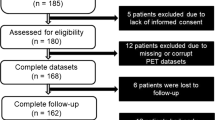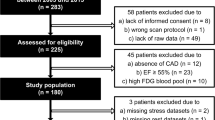Abstract
Objective
We aimed to evaluate the feasibility of resting myocardial blood flow (rMBF), quantified with dynamic 13 N-Ammonia (NH3) PET, for identifying myocardial viability and predicting improvement of left ventricular ejection fraction (LVEF) after coronary artery bypass grafting (CABG).
Methods
Ninety-three patients with coronary artery disease (CAD) and chronic LVEF < 45%, scheduled for CABG, had dynamic 13NH3 PET and 18F-FDG PET imaging. The perfusion/metabolism polar maps were categorized in four patterns: normal (N), mismatch (M1), match (M2) and reverse mismatch (RM). The value of rMBF for identifying viable myocardium (M1, RM) and post CABG improvement of LVEF≥8% was analyzed by receiver operating characteristic (ROC) curves. Correlations of rMBF in segments to ΔLVEF post CABG were verified.
Results
Mean rMBFs were significantly different (N=0.60±0.14; M1=0.44±0.07, M2=0.34±0.08, RM=0.53±0.09 ml/min/g, P<0.001). The optimal rMBF cutoff to identify viable myocardium was 0.42 ml/min/g (sensitivity=88.3%, specificity=82.0%) and 0.43 ml/min/g for predicting improvement of LVEF ≥8% (74.6%, 80.0%). The extent and rMBF of combined M1/RM demonstrated a moderate to high correlation to improved LVEF (r=0.78, 0.71, P<0.001).
Conclusion
Resting MBF, derived by dynamic 13NH3 PET, may be positioned as a supplement to 18F-FDG PET imaging for assessing the presence of viable myocardium and predicting potential improvement of LVEF after CABG.







Similar content being viewed by others
Abbreviations
- AC:
-
Accuracy
- AUC:
-
Area under curve
- CABG:
-
Coronary artery bypass grafting
- CT:
-
Computed X-ray tomography
- 18F-FDG:
-
18Fluor-2-fluoro-2-deoxyglucose
- LVEF:
-
Left ventricular ejection fraction
- MBF:
-
Myocardial blood flow
- 13NH3 :
-
13Nitrogen-Ammonia
- NPV:
-
Negative predictive value
- PET:
-
Positron emission tomography
- PPV:
-
Positive predictive value
- ROC:
-
Receiver operating characteristic
- RPC:
-
Reproducibility coefficient
- SRS:
-
Summed rest score
References
Tillisch J, Brunken R, Marshall R, et al. Reversibility of cardiac wall-motion abnormalities predicted in positron tomography. N Engl J Med. 1986;314:884–8.
Nienaber CA, Brunken RC, Sherman CT, et al. Metabolic and functional recovery of ischemic human myocardium after coronary angioplasty. J Am Coll Cardiol. 1991;18:966–78.
Marwick TH, Zuchowski C, Lauer MS, et al. Functional status and quality of life in patients with heart failure undergoing coronary bypass surgery after assessment of myocardial viability. J Am Coll Cardiol. 1999;33(3):750–8.
Vom-Dahl J, Eitzman DT, Al-Aouar ZR, et al. Relation of regional function, perfusion and metabolism in patients with advanced coronary artery diseased undergoing surgical revascularization. Circulation. 1994;90:2356–66.
Christakis GT, Weisel RD, Fremes SE. Coronary artery bypass grafting in patients with poor ventricular function. J Thorac Cardiovasc Surg. 1993;103:1083–92.
Elefteriades JA, Tolis G, Levi E. Coronary artery bypass grafting in severe left ventricular dysfunction: excellent survival and improved ejection fraction and functional state. J Am Coll Cardiol. 1993;22:1411–7.
Dreyfus GD, Duboc D, Blasco A, et al. Myocardial viability assessment in ischemic cardiomyopathy: benefits of coronary revascularization. Ann Thorac Surg. 1994;57:1402–7.
Schinkel AF, Poldermans D, Rizzello V, et al. Impact of diabetes mellitus on prediction of clinical outcome after coronary revascularization by 18F-FDG SPECT in patients with ischemic left ventricular dysfunction. J Nucl Med. 2006;47(1):68–73.
Schöder H, Campisi R, Ohtake T, et al. Blood flow-metabolism imaging with positron emission tomography in patients with diabetes mellitus for the assessment of reversible left ventricular contractile dysfunction. J Am Coll Cardiol. 1999;33(5):1328–37.
Gerber BL, Vanoverschelde JL, Bol A, et al. Myocardial blood flow, glucose uptake, and recruitment of inotropic reserve in chronic left ventricular ischemic dysfunction. Implications for the pathophysiology of chronic myocardial hibernation. Circulation. 1996;94(4):651–9.
Ziadi MC, Dekemp RA, Williams K, et al. Does quantification of myocardial flow reserve using rubidium-82 positron emission tomography facilitate detection of multivessel coronary artery disease? J Nucl Cardiol. 2012;19:670–80.
Maddahi J, Packard RRS. PET should replace SPECT in cardiac imaging for diagnosis and risk assessment of patients with known or suspected. CAD: Pro J Nucl Cardiol. 2017;24(6):1955–9.
Al-Badarin F, Aljizeeri A, Almasoudi F, et al. Assessment of myocardial blood flow and coronary flow reserve with positron emission tomography in ischemic heart disease: current state and future directions. Heart Fail Rev. 2017;22(4):441–3.
Fiechter M, Ghadri JR, Gebhard C, et al. Diagnostic value of 13 N-ammonia myocardial perfusion PET: added value of myocardial flow reserve. J Nucl Med. 2012;53(8):1230–4.
Herzog BA, Husmann L, Valenta I, et al. Long-term prognostic value of 13 N-ammonia myocardial perfusion positron emission tomography added value of coronary flow reserve. J Am Coll Cardiol. 2009;54:150–6.
Tawakol A, Skopicki HA, Abraham SA, et al. Evidence of reduce resting blood flow in viable myocardial regions with chronic asynergy. J Am Coll Cardiol. 2000;36:2146–53.
Prato FS, Butler J, Sykes J, et al. Can the inflammatory response be evaluated using 18F-FDG within zones of microvascular obstruction after myocardial infarction? J Nucl Med. 2015 Feb;56(2):299–304.
Schiller NB, Shah PM, Crawford M, et al. Recommendations for quantitation of the left ventricle by two-dimensionalechocardiography. American Society of Echocardiography Committee onStandards, Subcommittee on Quantitation of Two-Dimensional Echocardiograms. J Am Soc Echocardiogr. 1989;2(5):358–67.
Dorbala S, DiCarli MF, Delbeke D, et al. SNMMI/ASNC/SCCT Guideline for Cardiac SPECT/CT and PET/CT 1.0. J Nucl Med. 2013;54(8):1485.
Vennart NJ, Bird N, Buscombe J, et al. Optimization of PET/CT image quality using the GE ‘Sharp IR’ point-spread function reconstruction algorithm. Nucl Med Commun. 2017;38(6):471–9.
Slomka PJ, Alexanderson E, Jácome R, et al. Comparison of clinical tools for measurements of regional stress and rest myocardial blood flow assessed with 13 N-ammonia PET/CT. J Nucl Med. 2012;53(2):171–81.
Dorbala S, Ananthasubramaniam K, Armstrong IS, et al. Single photon emission computed tomography (SPECT) myocardial perfusion imaging guidelines: instrumentation, acquisition, processing, and interpretation. J Nucl Cardiol. 2018;25(5):1784–846.
Dilsizian V, Bacharach SL, Beanlands RS. ASNC Imaging Guidelines for Nuclear Cardiology Procedures: Standardized Reporting of Radionuclide Myocardial Perfusion and Function http://www.asnc.org July 2009.
Müller-Ehmsen J, Tossios P, Schmidt M, et al. Transmurality of scar influences the effect of a hybrid-intervention with autologous bone marrow cell injection and aortocoronary bypass surgery (MNC/CABG) in patients after myocardial infarction. Int. J. Cardiol. 2012;156(3):303–8.
Gewirtz H, Fischman AJ, Abraham S, et al. Positron emission tomographic measurements of absolute regional myocardial blood flow permits identification of nonviable myocardium in patients with chronic myocardial infarction. J. Am. Coll. Cardiol. 1994;23(4):851–9.
Aramayo Gerónimo EN, Osorio AR, Geronazzo RJ, et al. Relationship between myocardial viability, myocardial flow and coronary anatomy by positron emission tomography integrated with multislice computed tomography. Rev Argent Cardiol. 2013;81:113–8.
Beanlands RS, deKemp R, Scheffel A, et al. Can nitrogen-13 Ammonia kinetic modeling define myocardial viability independent of Fluorine-18 fluorodeoxyglucose? J Am Coll Cardiol. 1997;29(3):537–43.
Benz DC, Ferro P, Safa N, et al. Role of quantitative myocardial blood flow and N-ammonia washout for viability assessment in ischemic cardiomyopathy. J Nucl Cardiol. 2019. https://doi.org/10.1007/s12350-019-01684-1.
Zhang X, Schindler TH, Prior JO, et al. Blood flow, flow reserve, and glucose utilization in viable and nonviable myocardium in patients with ischemic cardiomyopathy. Eur J Nucl Med Mol Imaging. 2013;40(4):532–41.
Beanlands RS, Ruddy TD, deKemp RA, et al. Positron emission tomography and recovery following revascularization (PARR-1): the importance of scar and the development of a prediction rule for the degree of recovery of left ventricular function. J Am Coll Cardiol. 2002;40(10):1735–43.
Acknowledgements
This research was supported by the research grant from Key Project of Tianjin Health and Family Planning Commission, Tianjin City, China (Grant Number: 16KG145), and Health and Technology Project of Tianjin Binhai New Health Bureau, Tianjin City, China (Grant Number: 2015BWKL002). This article was finalized under the auspices of the ‘‘Mentorship at Distance’’ committee of the Journal of Nuclear Cardiology. We gratefully acknowledge the editorial suggestions by Professor Frans J. Th. Wackers, MD, PhD.
Conflict of interest
All authors declare that they have no conflict of interest.
Author information
Authors and Affiliations
Corresponding authors
Additional information
Publisher's Note
Springer Nature remains neutral with regard to jurisdictional claims in published maps and institutional affiliations.
The authors of this article have provided a PowerPoint file, available for download at SpringerLink, which summarises the contents of the paper and is free for re-use at meetings and presentations. Search for the article DOI on SpringerLink.com.
Electronic supplementary material
Below is the link to the electronic supplementary material.
Rights and permissions
About this article
Cite this article
Wang, J., Li, Jm., Li, S. et al. Absolute Resting 13N-Ammonia PET Myocardial Blood Flow for Predicting Myocardial Viability and Recovery of Ventricular Function after Coronary Artery Bypass Grafting. J. Nucl. Cardiol. 29, 987–999 (2022). https://doi.org/10.1007/s12350-020-02388-7
Received:
Accepted:
Published:
Issue Date:
DOI: https://doi.org/10.1007/s12350-020-02388-7




